2017 KIA SOUL belt
[x] Cancel search: beltPage 475 of 589
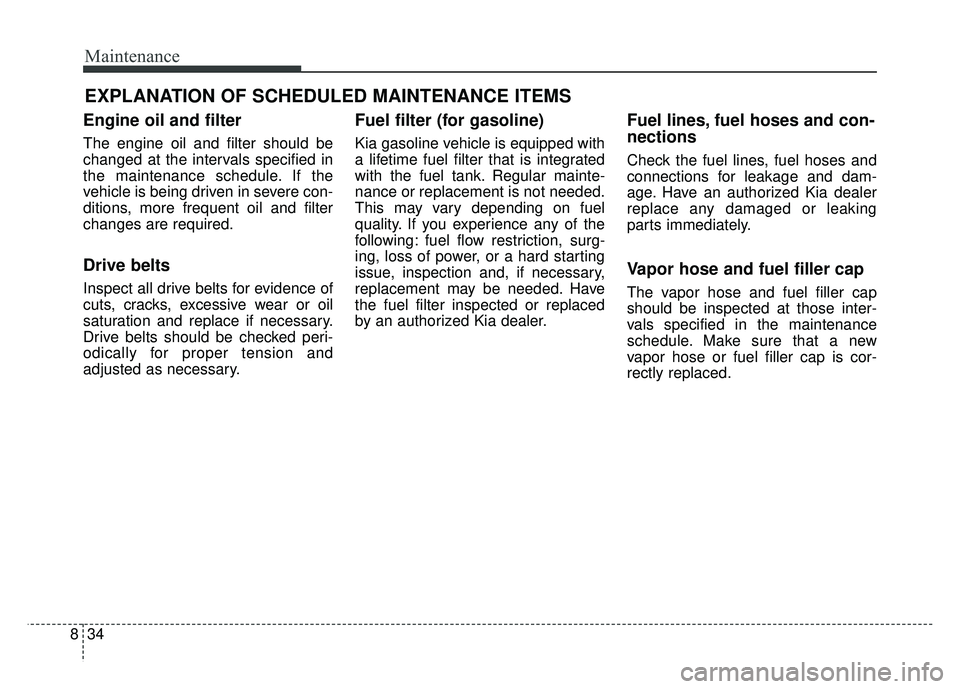
Maintenance
34
8
EXPLANATION OF SCHEDULED MAINTENANCE ITEMS
Engine oil and filter
The engine oil and filter should be
changed at the intervals specified in
the maintenance schedule. If the
vehicle is being driven in severe con-
ditions, more frequent oil and filter
changes are required.
Drive belts
Inspect all drive belts for evidence of
cuts, cracks, excessive wear or oil
saturation and replace if necessary.
Drive belts should be checked peri-
odically for proper tension and
adjusted as necessary.
Fuel filter (for gasoline)
Kia gasoline vehicle is equipped with
a lifetime fuel filter that is integrated
with the fuel tank. Regular mainte-
nance or replacement is not needed.
This may vary depending on fuel
quality. If you experience any of the
following: fuel flow restriction, surg-
ing, loss of power, or a hard starting
issue, inspection and, if necessary,
replacement may be needed. Have
the fuel filter inspected or replaced
by an authorized Kia dealer.
Fuel lines, fuel hoses and con-
nections
Check the fuel lines, fuel hoses and
connections for leakage and dam-
age. Have an authorized Kia dealer
replace any damaged or leaking
parts immediately.
Vapor hose and fuel filler cap
The vapor hose and fuel filler cap
should be inspected at those inter-
vals specified in the maintenance
schedule. Make sure that a new
vapor hose or fuel filler cap is cor-
rectly replaced.
Page 508 of 589
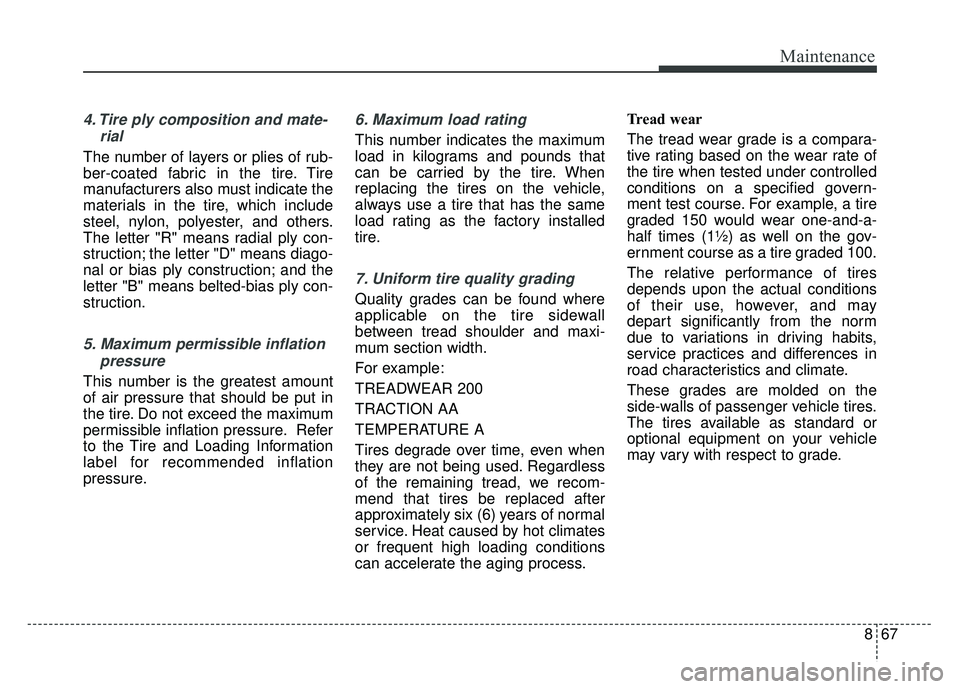
867
Maintenance
4. Tire ply composition and mate-rial
The number of layers or plies of rub-
ber-coated fabric in the tire. Tire
manufacturers also must indicate the
materials in the tire, which include
steel, nylon, polyester, and others.
The letter "R" means radial ply con-
struction; the letter "D" means diago-
nal or bias ply construction; and the
letter "B" means belted-bias ply con-
struction.
5. Maximum permissible inflationpressure
This number is the greatest amount
of air pressure that should be put in
the tire. Do not exceed the maximum
permissible inflation pressure. Refer
to the Tire and Loading Information
label for recommended inflation
pressure.
6. Maximum load rating
This number indicates the maximum
load in kilograms and pounds that
can be carried by the tire. When
replacing the tires on the vehicle,
always use a tire that has the same
load rating as the factory installed
tire.
7. Uniform tire quality grading
Quality grades can be found where
applicable on the tire sidewall
between tread shoulder and maxi-
mum section width.
For example:
TREADWEAR 200
TRACTION AA
TEMPERATURE A
Tires degrade over time, even when
they are not being used. Regardless
of the remaining tread, we recom-
mend that tires be replaced after
approximately six (6) years of normal
service. Heat caused by hot climates
or frequent high loading conditions
can accelerate the aging process. Tread wear
The tread wear grade is a compara-
tive rating based on the wear rate of
the tire when tested under controlled
conditions on a specified govern-
ment test course. For example, a tire
graded 150 would wear one-and-a-
half times (1½) as well on the gov-
ernment course as a tire graded 100.
The relative performance of tires
depends upon the actual conditions
of their use, however, and may
depart significantly from the norm
due to variations in driving habits,
service practices and differences in
road characteristics and climate.
These grades are molded on the
side-walls of passenger vehicle tires.
The tires available as standard or
optional equipment on your vehicle
may vary with respect to grade.
Page 509 of 589
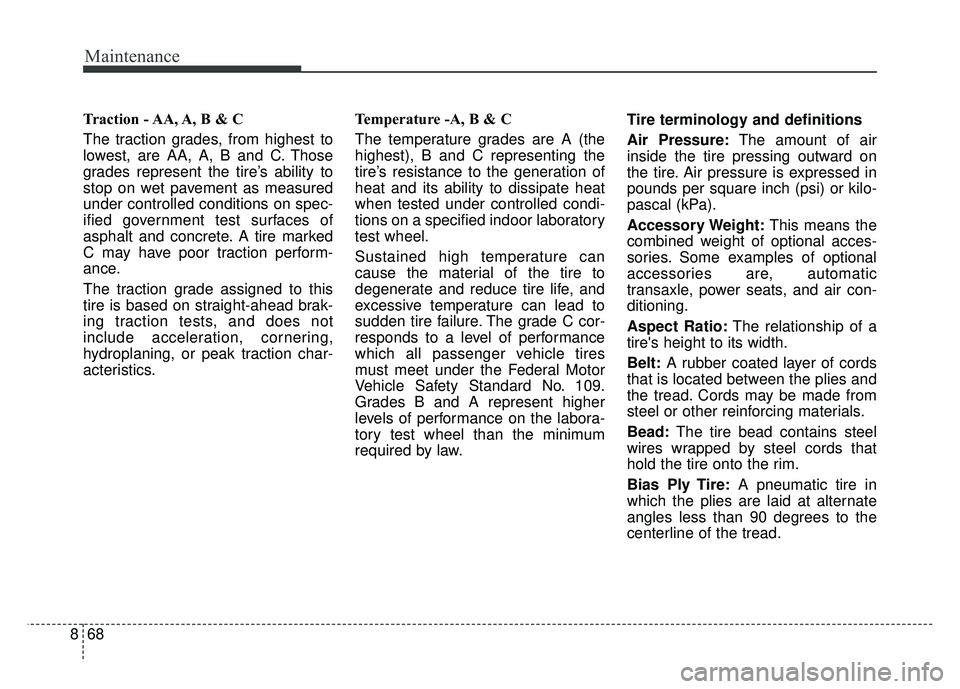
Maintenance
68
8
Traction - AA, A, B & C
The traction grades, from highest to
lowest, are AA, A, B and C. Those
grades represent the tire’s ability to
stop on wet pavement as measured
under controlled conditions on spec-
ified government test surfaces of
asphalt and concrete. A tire marked
C may have poor traction perform-
ance.
The traction grade assigned to this
tire is based on straight-ahead brak-
ing traction tests, and does not
include acceleration, cornering,
hydroplaning, or peak traction char-
acteristics. Temperature -A, B & C
The temperature grades are A (the
highest), B and C representing the
tire’s resistance to the generation of
heat and its ability to dissipate heat
when tested under controlled condi-
tions on a specified indoor laboratory
test wheel.
Sustained high temperature can
cause the material of the tire to
degenerate and reduce tire life, and
excessive temperature can lead to
sudden tire failure. The grade C cor-
responds to a level of performance
which all passenger vehicle tires
must meet under the Federal Motor
Vehicle Safety Standard No. 109.
Grades B and A represent higher
levels of performance on the labora-
tory test wheel than the minimum
required by law.Tire terminology and definitions
Air Pressure:
The amount of air
inside the tire pressing outward on
the tire. Air pressure is expressed in
pounds per square inch (psi) or kilo-
pascal (kPa).
Accessory Weight: This means the
combined weight of optional acces-
sories. Some examples of optional
accessories are, automatic
transaxle, power seats, and air con-
ditioning.
Aspect Ratio: The relationship of a
tire's height to its width.
Belt: A rubber coated layer of cords
that is located between the plies and
the tread. Cords may be made from
steel or other reinforcing materials.
Bead: The tire bead contains steel
wires wrapped by steel cords that
hold the tire onto the rim.
Bias Ply Tire: A pneumatic tire in
which the plies are laid at alternate
angles less than 90 degrees to the
centerline of the tread.
Page 513 of 589
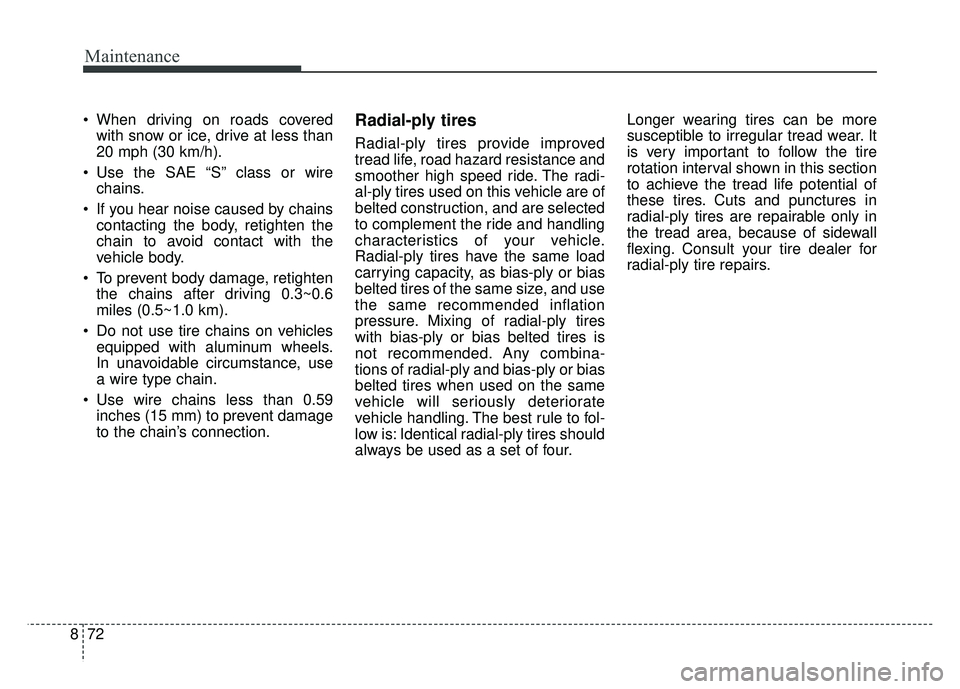
Maintenance
72
8
When driving on roads covered
with snow or ice, drive at less than
20 mph (30 km/h).
Use the SAE “S” class or wire chains.
If you hear noise caused by chains contacting the body, retighten the
chain to avoid contact with the
vehicle body.
To prevent body damage, retighten the chains after driving 0.3~0.6
miles (0.5~1.0 km).
Do not use tire chains on vehicles equipped with aluminum wheels.
In unavoidable circumstance, use
a wire type chain.
Use wire chains less than 0.59 inches (15 mm) to prevent damage
to the chain’s connection.Radial-ply tires
Radial-ply tires provide improved
tread life, road hazard resistance and
smoother high speed ride. The radi-
al-ply tires used on this vehicle are of
belted construction, and are selected
to complement the ride and handling
characteristics of your vehicle.
Radial-ply tires have the same load
carrying capacity, as bias-ply or bias
belted tires of the same size, and use
the same recommended inflation
pressure. Mixing of radial-ply tires
with bias-ply or bias belted tires is
not recommended. Any combina-
tions of radial-ply and bias-ply or bias
belted tires when used on the same
vehicle will seriously deteriorate
vehicle handling. The best rule to fol-
low is: Identical radial-ply tires should
always be used as a set of four. Longer wearing tires can be more
susceptible to irregular tread wear. It
is very important to follow the tire
rotation interval shown in this section
to achieve the tread life potential of
these tires. Cuts and punctures in
radial-ply tires are repairable only in
the tread area, because of sidewall
flexing. Consult your tire dealer for
radial-ply tire repairs.
Page 554 of 589
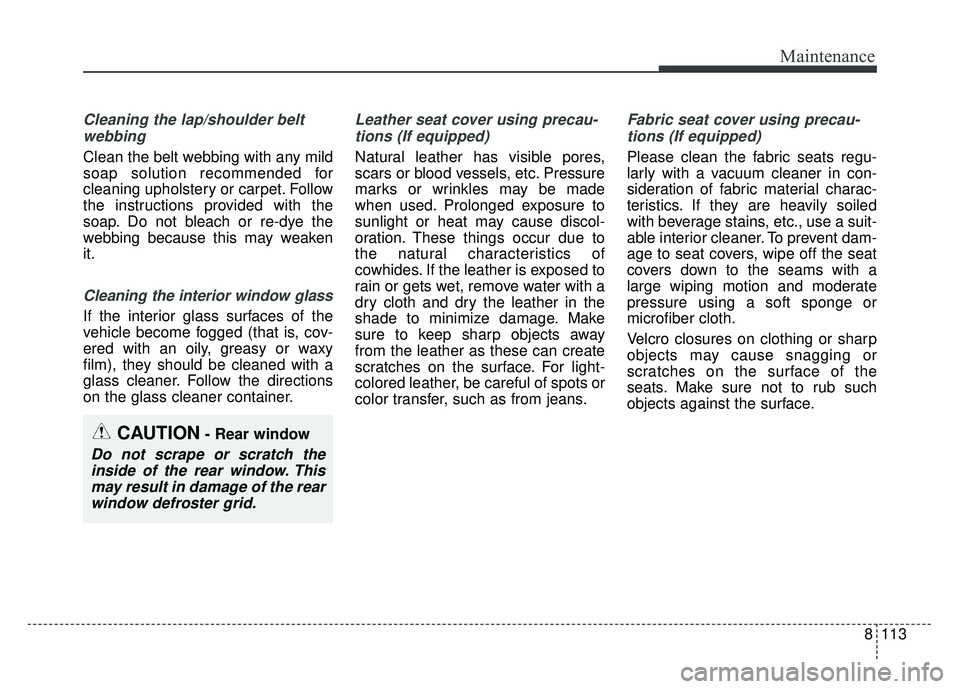
8113
Maintenance
Cleaning the lap/shoulder beltwebbing
Clean the belt webbing with any mild
soap solution recommended for
cleaning upholstery or carpet. Follow
the instructions provided with the
soap. Do not bleach or re-dye the
webbing because this may weaken
it.
Cleaning the interior window glass
If the interior glass surfaces of the
vehicle become fogged (that is, cov-
ered with an oily, greasy or waxy
film), they should be cleaned with a
glass cleaner. Follow the directions
on the glass cleaner container.
Leather seat cover using precau-tions (If equipped)
Natural leather has visible pores,
scars or blood vessels, etc. Pressure
marks or wrinkles may be made
when used. Prolonged exposure to
sunlight or heat may cause discol-
oration. These things occur due to
the natural characteristics of
cowhides. If the leather is exposed to
rain or gets wet, remove water with a
dry cloth and dry the leather in the
shade to minimize damage. Make
sure to keep sharp objects away
from the leather as these can create
scratches on the surface. For light-
colored leather, be careful of spots or
color transfer, such as from jeans.
Fabric seat cover using precau-tions (If equipped)
Please clean the fabric seats regu-
larly with a vacuum cleaner in con-
sideration of fabric material charac-
teristics. If they are heavily soiled
with beverage stains, etc., use a suit-
able interior cleaner. To prevent dam-
age to seat covers, wipe off the seat
covers down to the seams with a
large wiping motion and moderate
pressure using a soft sponge or
microfiber cloth.
Velcro closures on clothing or sharp
objects may cause snagging or
scratches on the surface of the
seats. Make sure not to rub such
objects against the surface.
CAUTION- Rear window
Do not scrape or scratch theinside of the rear window. Thismay result in damage of the rearwindow defroster grid.
Page 558 of 589

8117
Maintenance
Your vehicle is equipped with a cat-
alytic converter emission control
device.
Therefore, the following precautions
must be observed:
Use only UNLEADED FUEL forgasoline engines.
Do not operate the vehicle when there are signs of engine malfunc-
tion, such as misfire or a noticeable
loss of performance.
Do not misuse or abuse the engine. Examples of misuse are
coasting with the ignition off and
descending steep grades in gear
with the ignition off.
Do not operate the engine at high idle speed for extended periods (5
minutes or more).
Do not modify or tamper with any part of the engine or emission con-
trol system. All inspections and
adjustments must be made by an
authorized Kia dealer.
Avoid driving with a extremely low fuel level. Running out of fuel could
cause the engine to misfire, dam-
aging the catalytic converter. Failure to observe these precautions
could result in damage to the catalyt-
ic converter and to your vehicle.
Additionally, such actions could void
your warranties.
Perchlorate Material-special handling
may apply, See www.dtsc.ca.gov/haz-
ardouswaste/ perchlorate.
Notice to California Vehicle Dismantlers:
Perchlorate containing materials,
such as air bag inflators, seatbelt
pretensioners and keyless remote
entry batteries, must be disposed of
according to Title 22 California Code
of Regulations Section 67384.10 (a).
CALIFORNIA
PERCHLORATE NOTICE
Page 577 of 589
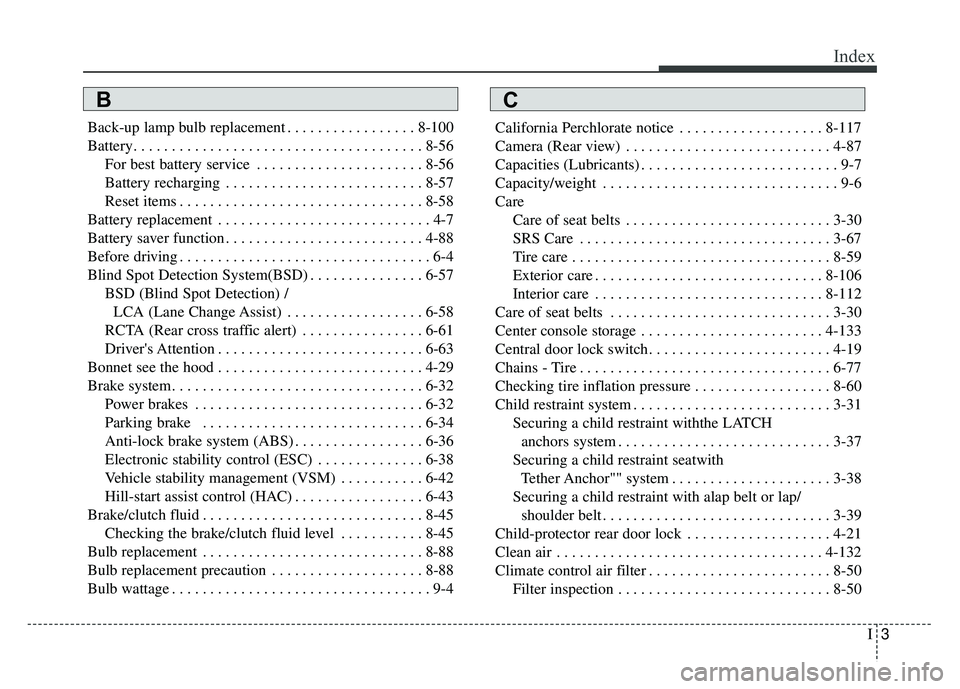
I3
Index
Back-up lamp bulb replacement . . . . . . . . . . . . . . . . . 8-100
Battery. . . . . . . . . . . . . . . . . . . . . . . . . . . . . . . . . . . . \
. . 8-56For best battery service . . . . . . . . . . . . . . . . . . . . . . 8-56
Battery recharging . . . . . . . . . . . . . . . . . . . . . . . . . . 8-57
Reset items . . . . . . . . . . . . . . . . . . . . . . . . . . . . . . . . 8-58
Battery replacement . . . . . . . . . . . . . . . . . . . . . . . . . . . . 4-7
Battery saver function . . . . . . . . . . . . . . . . . . . . . . . . . . 4-88
Before driving . . . . . . . . . . . . . . . . . . . . . . . . . . . . . . . . . 6-4
Blind Spot Detection System(BSD) . . . . . . . . . . . . . . . 6-57 BSD (Blind Spot Detection) /LCA (Lane Change Assist) . . . . . . . . . . . . . . . . . . 6-58
RCTA (Rear cross traffic alert) . . . . . . . . . . . . . . . . 6-61
Driver's Attention . . . . . . . . . . . . . . . . . . . . . . . . . . . 6-63
Bonnet see the hood . . . . . . . . . . . . . . . . . . . . . . . . . . . 4-29
Brake system. . . . . . . . . . . . . . . . . . . . . . . . . . . . . . . . . 6-32 Power brakes . . . . . . . . . . . . . . . . . . . . . . . . . . . . . . 6-32
Parking brake . . . . . . . . . . . . . . . . . . . . . . . . . . . . . 6-34
Anti-lock brake system (ABS) . . . . . . . . . . . . . . . . . 6-36
Electronic stability control (ESC) . . . . . . . . . . . . . . 6-38
Vehicle stability management (VSM) . . . . . . . . . . . 6-42
Hill-start assist control (HAC) . . . . . . . . . . . . . . . . . 6-43
Brake/clutch fluid . . . . . . . . . . . . . . . . . . . . . . . . . . . . . 8-45 Checking the brake/clutch fluid level . . . . . . . . . . . 8-45
Bulb replacement . . . . . . . . . . . . . . . . . . . . . . . . . . . . . 8-88
Bulb replacement precaution . . . . . . . . . . . . . . . . . . . . 8-88
Bulb wattage . . . . . . . . . . . . . . . . . . . . . . . . . . . . . . . . . . 9-4 California Perchlorate notice . . . . . . . . . . . . . . . . . . . 8-117
Camera (Rear view) . . . . . . . . . . . . . . . . . . . . . . . . . . . 4-87
Capacities (Lubricants) . . . . . . . . . . . . . . . . . . . . . . . . . . 9-7
Capacity/weight . . . . . . . . . . . . . . . . . . . . . . . . . . . . . . . 9-6
Care
Care of seat belts . . . . . . . . . . . . . . . . . . . . . . . . . . . 3-30
SRS Care . . . . . . . . . . . . . . . . . . . . . . . . . . . . . . . . . 3-67
Tire care . . . . . . . . . . . . . . . . . . . . . . . . . . . . . . . . . . 8-59\
Exterior care . . . . . . . . . . . . . . . . . . . . . . . . . . . . . . 8-106
Interior care . . . . . . . . . . . . . . . . . . . . . . . . . . . . . . 8-112
Care of seat belts . . . . . . . . . . . . . . . . . . . . . . . . . . . . . 3-30
Center console storage . . . . . . . . . . . . . . . . . . . . . . . . 4-133
Central door lock switch. . . . . . . . . . . . . . . . . . . . . . . . 4-19
Chains - Tire . . . . . . . . . . . . . . . . . . . . . . . . . . . . . . . . . 6-77
Checking tire inflation pressure . . . . . . . . . . . . . . . . . . 8-60
Child restraint system . . . . . . . . . . . . . . . . . . . . . . . . . . 3-31 Securing a child restraint withthe LATCHanchors system . . . . . . . . . . . . . . . . . . . . . . . . . . . . 3-37
Securing a child restraint seatwith Tether Anchor"" system . . . . . . . . . . . . . . . . . . . . . 3-38
Securing a child restraint with alap belt or lap/ shoulder belt . . . . . . . . . . . . . . . . . . . . . . . . . . . . . . 3-39
Child-protector rear door lock . . . . . . . . . . . . . . . . . . . 4-21
Clean air . . . . . . . . . . . . . . . . . . . . . . . . . . . . . . . . . . . 4-\
132
Climate control air filter . . . . . . . . . . . . . . . . . . . . . . . . 8-50 Filter inspection . . . . . . . . . . . . . . . . . . . . . . . . . . . . 8-50
BC
Page 579 of 589

I5
Index
ECO mode (Drive mode integrated control system) . . 6-50
Economical operation . . . . . . . . . . . . . . . . . . . . . . . . . . 6-69
Electric power steering . . . . . . . . . . . . . . . . . . . . . . . . . 4-39
ELECTRICAL EQUIPMENT . . . . . . . . . . . . . . . . . . . 9-15
Electrochromic mirror (ECM) . . . . . . . . . . . . . . . . . . . 4-44
Electronic stability control (ESC) . . . . . . . . . . . . . . . . 6-38
Emergency starting . . . . . . . . . . . . . . . . . . . . . . . . . . . . . 7-5Jump starting . . . . . . . . . . . . . . . . . . . . . . . . . . . . . . . 7-5
Emergency while driving . . . . . . . . . . . . . . . . . . . . . . . . 7-3
Emission control system . . . . . . . . . . . . . . . . . . . . . . . 8-114 Crankcase emission control system . . . . . . . . . . . . 8-114
Evaporative emission control (including ORVR:Onboard Refueling Vapor Recovery) system. . . . 8-114
Exhaust emission control system . . . . . . . . . . . . . . 8-115
Engine . . . . . . . . . . . . . . . . . . . . . . . . . . . . . . . . . . . . \
. . . 9-3
Engine compartment . . . . . . . . . . . . . . . . . . . . . . . . . . . . 2-6
Engine compartment . . . . . . . . . . . . . . . . . . . . . . . . . . . . 8-3
Engine coolant . . . . . . . . . . . . . . . . . . . . . . . . . . . . . . . 8-41 Checking the coolant level . . . . . . . . . . . . . . . . . . . . 8-41
Changing the coolant . . . . . . . . . . . . . . . . . . . . . . . . 8-44
Engine Coolant Temperature Gauge. . . . . . . . . . . . . . . 4-51
Engine number . . . . . . . . . . . . . . . . . . . . . . . . . . . . . . . 9-11
Engine oil . . . . . . . . . . . . . . . . . . . . . . . . . . . . . . . . . . . 8-\
39 Checking the engine oil level . . . . . . . . . . . . . . . . . . 8-39
Changing the engine oil and filter . . . . . . . . . . . . . . 8-40
Engine overheats . . . . . . . . . . . . . . . . . . . . . . . . . . . . . . . 7-8 Engine start/stop button . . . . . . . . . . . . . . . . . . . . . . . . . 6-9
Illuminated engine start/stop button. . . . . . . . . . . . . . 6-9
Engine start/stop button position . . . . . . . . . . . . . . . . 6-9
Starting the engine . . . . . . . . . . . . . . . . . . . . . . . . . . 6-11
Engine start/stop button illumination . . . . . . . . . . . . . . . 6-9
Engine start/stop button position . . . . . . . . . . . . . . . . . . 6-9
Engine will not start . . . . . . . . . . . . . . . . . . . . . . . . . . . . 7-4
Evaporative emission control (including ORVR: Onboard Refueling Vapor Recovery) system . . . . . 8-114
Exhaust emission control system . . . . . . . . . . . . . . . . 8-115
Explanation of scheduled maintenance items . . . . . . . 8-34 Engine oil and filter . . . . . . . . . . . . . . . . . . . . . . . . . 8-34
Drive belts . . . . . . . . . . . . . . . . . . . . . . . . . . . . . . . . 8-34
Fuel filter (for gasoline) . . . . . . . . . . . . . . . . . . . . . . 8-34
Fuel lines, fuel hoses and connections . . . . . . . . . . . 8-34
Vapor hose and fuel filler cap . . . . . . . . . . . . . . . . . 8-34
Vacuum crankcase ventilation hoses . . . . . . . . . . . . 8-35
Air cleaner filter . . . . . . . . . . . . . . . . . . . . . . . . . . . . 8-35
Spark plugs . . . . . . . . . . . . . . . . . . . . . . . . . . . . . . . . 8-35
Valve clearance. . . . . . . . . . . . . . . . . . . . . . . . . . . . . 8-35
Cooling system . . . . . . . . . . . . . . . . . . . . . . . . . . . . . 8-35
Coolant . . . . . . . . . . . . . . . . . . . . . . . . . . . . . . . . . . 8-35\
Manual transaxle fluid . . . . . . . . . . . . . . . . . . . . . . . 8-36
Automatic transaxle fluid . . . . . . . . . . . . . . . . . . . . . 8-36
Dual clutch transmission fluid . . . . . . . . . . . . . . . . . 8-36
Brake hoses and lines . . . . . . . . . . . . . . . . . . . . . . . . 8-36
Brake/clutch fluid . . . . . . . . . . . . . . . . . . . . . . . . . . . 8-37
Parking brake . . . . . . . . . . . . . . . . . . . . . . . . . . . . . 8-37
E